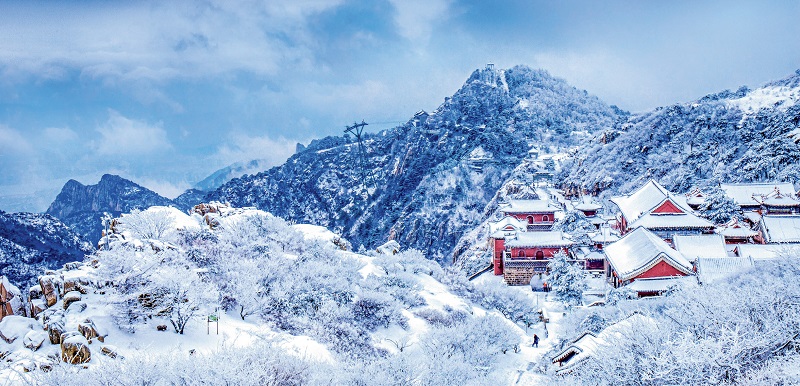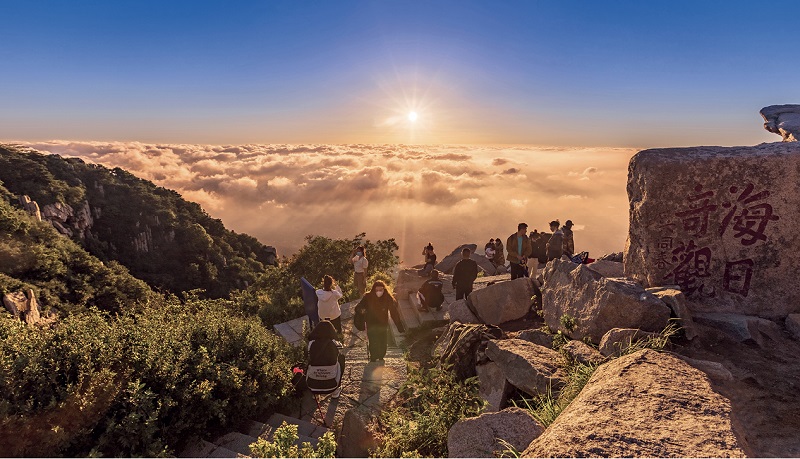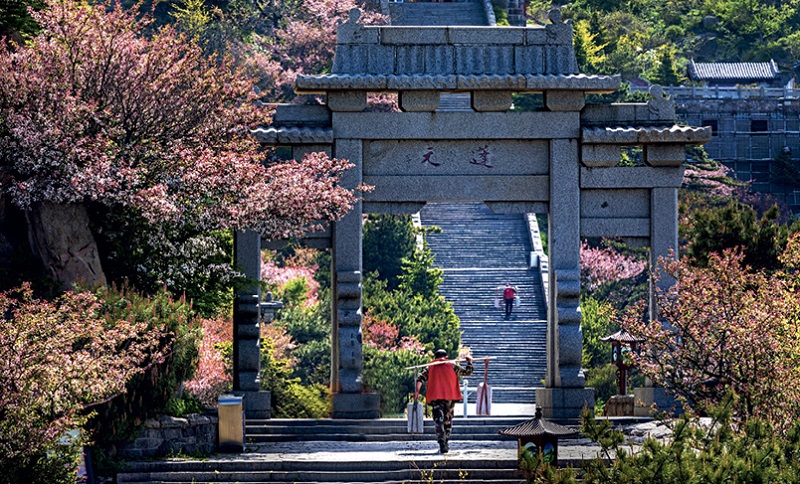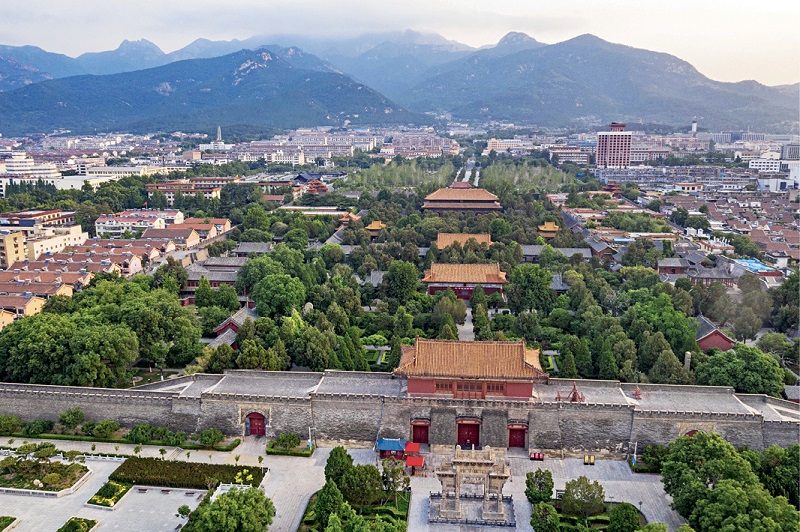Mount Taishan is one of the spiritual symbols of Chinese civilization, and an imperial, ritual place where emperors once paid homage to heaven and earth.
Located in the central part of east China’s Shandong Province, Mount Taishan stretches more than 200 kilometers from east to west and 50 kilometers from north to south, with a total area of about 426 square kilometers and a maximum altitude of 1,545 meters. In ancient times, Chinese ancestors believed that heaven and earth were held up by five mountains, which were therefore revered as five sacred mountains, among which the easternmost mountain was Mount Taishan. Towering over the vast earth in the east, Taishan is the first among the five to welcome the rising sun, and ancient Chinese believed this was where life began. hence it is recognized as being supreme among the five sacred mountains.
From Yao, Shun, and Yu in ancient times, to Qin Shi Huang (the first emperor of a unified China), the ambitious Emperor Wudi of Han, Wu Zetian (the first and only empress of China), Emperor Kangxi and Emperor Qianlong of the Qing Dynasty (1644-1911), they all came to pay tribute to Mount Taishan. Its long history and magnificent natural scenery make Mount Taishan a world cultural and natural heritage, as well as a world geopark, a national forest park, and a 5A scenic area.

Taishan transformed into a frozen world after a heavy spring snowfall on March 1, 2021.
Daimiao Temple
Located at the foot of Mount Tai, Daimiao Temple is dedicated to the “God of Mount Taishan” and served as the major place for ancient Chinese emperors to worship the mountain gods. The entire temple is rectangular, with an area of 96,000 square meters. Historical records say that the temple has a long history, being first built in the Qin Dynasty (221-207 BC) and refined in the Han Dynasty (202 BC-AD 220). Following restructuring over 1,000 years, it gradually became a large-scale building complex. Today, the temple has 186 ancient and archaized buildings, 184 stone tablets, 48 stone portraits of the Han Dynasty, 212 ancient cypress and oriental arborvitae, and 292 species of ornamental plants.
The layout of the Dai Temple is primarily based on west, central, and east three parallel axes and forms a symmetrical structure that expands vertically and horizontally. The majestic grandeur of this configuration gives this complex a look of a real imperial palace. Dai Temple is also a refreshing classic garden. Ancient oriental arborvitae, the shade of the ginkgo, exquisite bonsai trees, and a variety of flowers all add natural air to the pastel buildings. Its year-round picturesque scenery attracts a steady stream of tourists from home and abroad.

Visitors viewing a glorious sunrise at a summit of Taishan on July 7, 2022.
The Imperial Trail
Serving as the imperial route for emperors for hundreds of years, the Red Gate hiking trail has long been the main route to the top, and also the central axis of Mount Taishan. With a number of stone inscriptions along the way, tourists can experience the thousands of years of Chinese history. The 8.9-kilometer climb with a total of 6,366 steps passes through the Red Gate, Zhong Tian Gate, Nan Tian Gate, and Yu Huang Peak, and takes the average person about four to five hours to reach the summit. Besides the natural landscape, along the climb there are eight ancient temples, more than 200 inscription stones and 300 cliff carvings.
The north-faced Guandi Temple sits at the start of the climb. However date of its construction is not clear. The four characters inscribed on the screen wall of the temple gate were written by Emperor Qianlong of Qing during his trip to Taishan. Guandi Temple is dotted with ancient trees, and in the backyard of its main hall, there is an ancient cypress tree with a peculiar shape. The main trunk of the tree is coiled and out of it grows three branches which grow intertwined. The trunk is only 0.8 meters high while its diameter is 1.1 meters, making it look like a coiled dragon. This cypress has been added to the World Heritage List.
Trekking uphill from the Guandi Temple stands a stone gate inscribed with the words meaning the spot where Confucius once stood, which is said to be the place where Confucius started climbing the mountain when he was young. To the north is the Red Gate Palace, named after a red wall on the cliff that looks like a gate.
Going up, you reach the Zhongtian Gate, which is halfway to the top. It was originally built in the Qing Dynasty. The adjacent attraction is the noted Yingke Pine which is one of the iconic spots of Taishan. Standing on top of the cliff, the pine is eight meters high and has a huge canopy with a long branch hanging down as if it is waving an arm to welcome the visitors. Although it has been through more than 500 springs and autumns, the tree is still bursting with energy and is considered a wonder of the mountain.
The climb up Taishan is one of the largest of its kind in ancient Chinese engineering history. The “Eighteen Bends” is the most dangerous section, which in turn has become a major highlight of climbing Taishan. It is a short 800-meter distance, yet with a total of about 1,800 stone steps and a height of more than 400 meters. Since the Han Dynasty, there has been a road leading to the top from the Nantian Gate, and according to expert analysis, stone steps were built during the Tang Dynasty (618-907). The stone strips connected together form a string of stone platforms. For thousands of years, Chinese emperors ascended Mount Taishan through this path. Looking from the foot of the hill, the trail zigzagging between imposing steep cliffs looks just like a staircase leading to heaven.
The Nantian Gate is located 1,460 meters above sea level and was created in the early Yuan Dynasty (1271-1368) with the fund raised by the head priest of Dai Temple. It sits on the central route, so visitors can see its lofty image from the foot of the mountain. Whenever mist clouds the mountain, the Nantian Gate seems to float in the sky and the path looks as if it is a ladder hanging upside down. The surrounding scenery at the gate is awesome enough to re-energize hiker’s fatigued bodies.
At the end of the climb is the Yuhuang Temple, perched at the highest point of Mount Taishan of 1,545 meters, which is considered a must-see spot. It is also the highest peak in Shandong Province. The pines, boulders, and clouds here are woven into the splendorous view of the imposing Taishan.

Chinese flowering crabapples add much charm to the natural beauty of Mount Taishan when in full blossom.
Sunrise and Stone Bridge
Watching the sunrise is top of the to-do-list at Taishan. On the east side of Yuhuang Peak, there is a 6.5-meter-long granite boulder named “Gongbei Stone.” This sharp-blade-shaped stone is inclined to the north at an angle of 30 degrees from the ground, and is also known as “Tanhai Stone” (meaning “exploring the sea” in Chinese) as its posture resembles rising up to explore the sea. Standing atop the steep cliff, it exudes the great strength and grandeur of the majestic Mount Taishan. Looking down from the peak, visitors can see the scenic view of the mountain when the sky is clear and a sea of clouds when it is cloudy, so it has naturally become a hotspot for sunrise watching.
The magnificent sunrise view in Mount Taishan has always been a beautiful and majestic image in the hearts of Chinese through the ages. Despite the limited space to view the sunrise, crowds inevitably congregate there all year round.
Another famous rock attraction on Mount Taishan is the Immortal Bridge. At the edge of the cliff, three giant stones subtly support each other and form a bridge that seems to be shaky but very steady. Under the middle stone there is a stone standing alone, like a bridge pier. Without this stone, the other three above would have fallen down long ago. Ancient people believed that this bizarre scene was created by immortals, so they called this place Immortal Bridge. However, in the eyes of a modern geologist, this is a typical “collapse and deposit” phenomenon.

Located at the foot of Taishan, Daimiao temple is dedicated to the "God of Mount Taishan.”
Rock Carvings
In addition to the natural rock landscape, many poetic inscriptions have been left on the rocks by Chinese literati over the ages, giving them unique character. These stone inscriptions not only show the exquisite art of calligraphy, but also record the sentiments of the Chinese intellectuals in different periods, as they all admired the mountain.
Jingshi Valley is a famous spot known for the largest surviving Buddhist sutra cliff carvings in China. On a vast stone slope spanning about 2,000 square meters, are engraved more than 1,000 words of the Diamond Sutra, and each inscribed character is about 50 centimeters long. With the carving of a Buddhist classic, Jingshi Valley was given its name, literally meaning Sutra Stone Valley. Only 41 lines of scripture can be seen now after more than 1,000 years of wind and rain erosion.
The Tang Cliff Carving is the most concentrated spot of inscriptions on Mount Taishan. The most famous inscription is the writing by Emperor Xuanzong of the Tang Dynasty in 725. The cliff is 1,320 centimeters high and 530 centimeters wide, and features 1,008 engraved characters, each with a diameter of 25 centimeters. The words are inscribed in clerical script, a style of Chinese writing, presenting bold and vigorous strokes.
Mount Taishan is a symbol of the Chinese nation, which integrates human culture and natural landscape. Visitors hiking in the valleys, or climbing the stairs to the summit, feel they are walking through, and witnessing, historical changes in Chinese civilization over thousands of years.